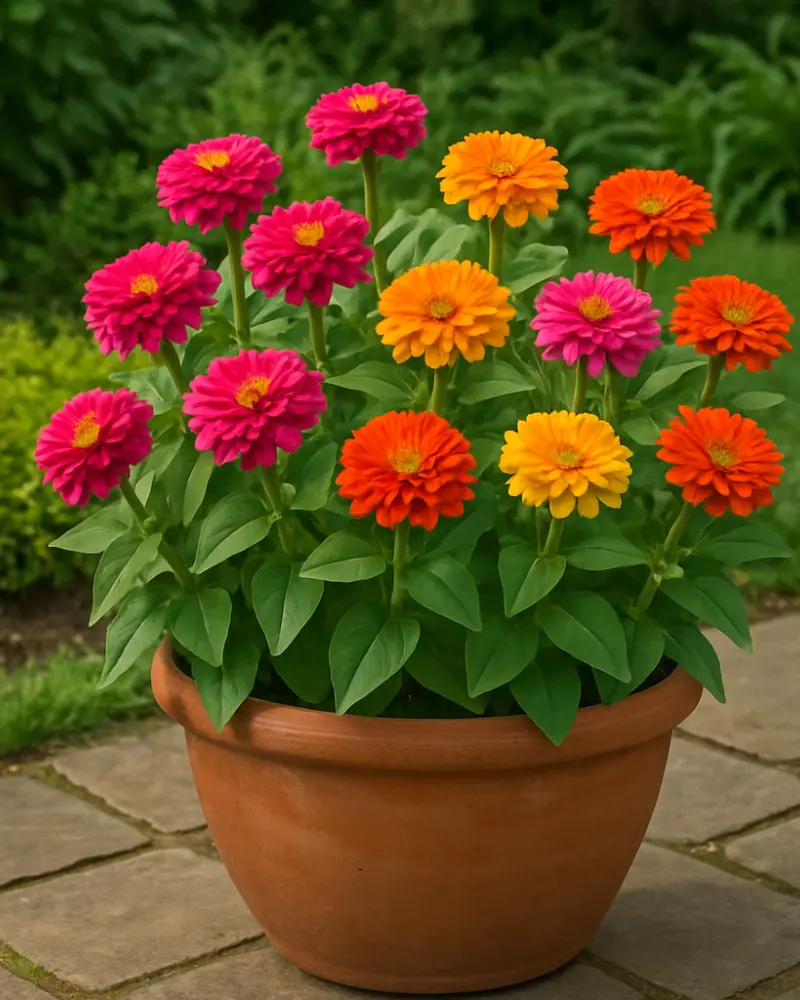Why Zinnias Are Your Garden’s Best Friend
Zinnias are the all-time favourite of gardening enthusiasts because of their vibrant, long-lasting blooms. They are best for converting your garden into an all-season garden. After planting Zinnias in your garden, be sure that they are going to stay there from summer till fall. They are easy-to-care-for plants that don’t demand fancy care routines and also attract pretty pollinators like butterflies to your garden.
Quick Benefits of Growing Zinnias
✅ Thrives in sun and heat
💧 Low maintenance
⏳ Long blooming season
✂️ Great for cut flowers and bouquets
🐝 Attracts bees and butterflies
Choosing The Right Zinnia Variety
Tall Vs Dwarf Varieties

Choosing the variety totally depends on your garden type, where you are looking to plant, or looking for any special arrangement. Tally variety can grow up to a height of 3-4 feet whereas Dwarf zinnias can reach a height of 6-12 inches.
Best Beginner-Friendly Types
If you are confused about which variety will suit your arrangement then no worries for complete greenhorn gardeners Zinnia elegans and Zinnia haageana are perfect choices, Both are easy-to-grow varieties that offer showy vibrant flowers giving your garden.
Tip – Here are some suggestions based on space, If you are choosing varieties for border arrangement then – Profusion, Queeny Lime, and Purple Prince are the best varieties.
For pots – Pick Zahara, Profusion, and Benary’s Giant.
For beds – Angustifolia and Grandiflora are best.
Step-By-Step: How To Grow Zinnias from Seeds
Timing & Location

The best time for planting zinnia is after the last frost ( April or May ) you can directly sow seeds in the ground when the soil has gained some warmth.
Choose a spot where it can have full sunlight. Zinnias doesn’t like to thrive in shady areas.
Soil Prep
Before planting, preparing the soil is a crucial thing. Use a garden fork to loosen the soil, remove small rocks if found, and amending them with organic manure or compost will enhance the soil draining capabilities releasing nutrients into the soil.
Sowing Seeds
Direct sowing Vs starting indoors
If you want you can start the sowing process indoors in any containers or module tray 3-4 prior to the sowing season so that when the season comes you can directly transplant your Zinnia into your desired location.
If you don’t want to put that much effort you can directly sow seeds in late spring.
Plant depth & spacing
For sowing Zinnia seeds depth of ¼ or ½ inch is sufficient and spacing between each plant depends on the variety. The larger variety needs 18 inches of spacing and Dwarf varieties want 6-12 inches of spacing.
Watering Tips For Germination
For proper and healthy Germination you need to keep the soil consistently moist by sprinkling water until the germination occurs, Don’t make the soil soggy because it can lead to root rot, after the germination process gives time to the soil to dry between next watering session.
First Sprouts To Full Blooms
I know the urge to see zinnias blooming after the planting process but be patient. The wait will be worth it; typically they start blooming after 60-70 days.
Care Tips For Healthy Zinnias
Watering Schedule
Water your plant either in the morning or evening if you are living in a city with scorching noon sunlight. You can check manually with your fingers whether your plants are thirsty are not if the soil feels dry after touching then they need to be watered.
Deadheading for more blooms

Deadheading the spent flowers is very important so that the plant can spend its energy in blooming new flowers. It’s also important for maintaining the aesthetic of your arrangement.
Pest & Disease Control
One of the most common pests that Zinnia foliage has to face is Alternaria Blight which is a fungal disease causing circular dark spots in Zinnia’s flower.
Remedies
Avoid showering your plant in the afternoon, if you are witnessing black spots and use fungicide.
Companion Plants To Pair with Zinnias
Cosmos , Alyssum , Petunia , Nasturtiums
Final Tips – What Most Beginners Get Wrong
- Overwatering
- Not Enough Sunlight
- Skipping Deadheading
- Forgetting To Thin Seedlings
Conclusion
Growing zinnias is one of the easiest and most rewarding ways to add vibrant color and life to your garden. With just a little sun, soil, and care, you’ll be enjoying cheerful blooms all summer long—no green thumb required!
Ready to get your hands dirty? Grab a pack of zinnia seeds and start planting this weekend. If you found this guide helpful, drop a comment below or share a photo of your zinnia garden with us on social media using #ZinniaGardenVibes. Happy gardening! 🌼💚

